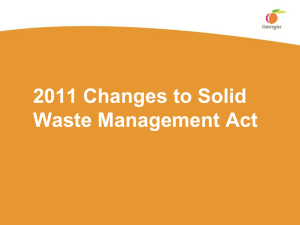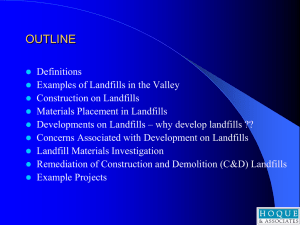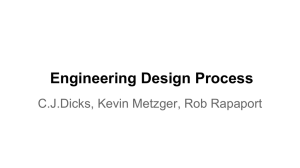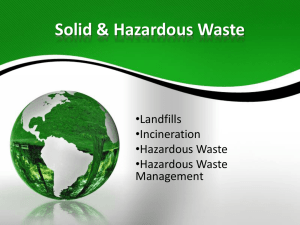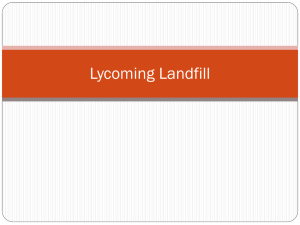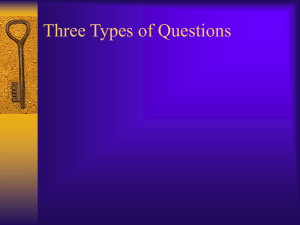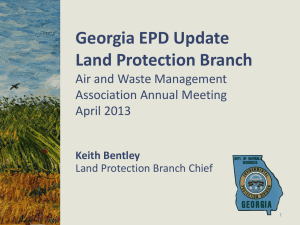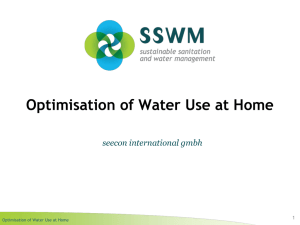Landfills - Sustainable Sanitation and Water Management Toolbox
advertisement
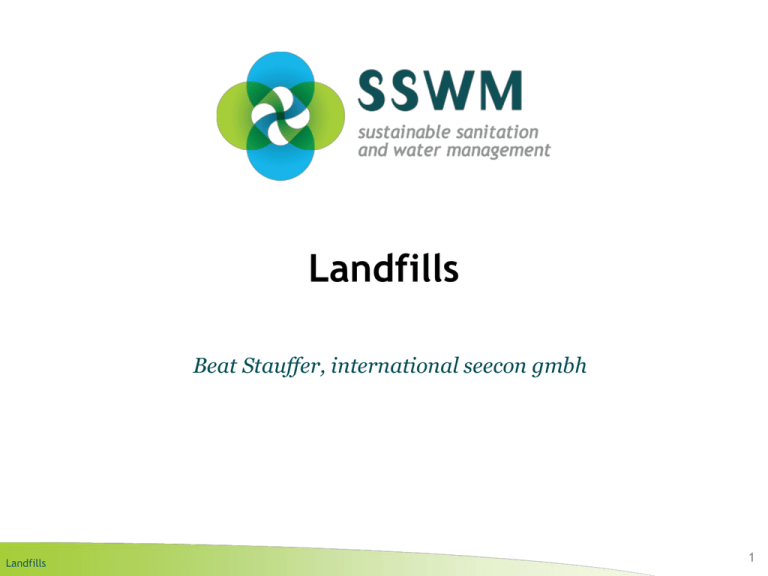
Landfills Beat Stauffer, international seecon gmbh Landfills 1 Find this presentation and more on: www.ssswm.info. Copyright & Disclaimer Copy it, adapt it, use it – but acknowledge the source! Copyright Included in the SSWM Toolbox are materials from various organisations and sources. Those materials are open source. Following the opensource concept for capacity building and non-profit use, copying and adapting is allowed provided proper acknowledgement of the source is made (see below). The publication of these materials in the SSWM Toolbox does not alter any existing copyrights. Material published in the SSWM Toolbox for the first time follows the same open-source concept, with all rights remaining with the original authors or producing organisations. To view an official copy of the the Creative Commons Attribution Works 3.0 Unported License we build upon, visit http://creativecommons.org/licenses/by/3.0. This agreement officially states that: You are free to: • Share - to copy, distribute and transmit this document • Remix - to adapt this document. We would appreciate receiving a copy of any changes that you have made to improve this document. Under the following conditions: • Attribution: You must always give the original authors or publishing agencies credit for the document or picture you are using. Disclaimer The contents of the SSWM Toolbox reflect the opinions of the respective authors and not necessarily the official opinion of the funding or supporting partner organisations. Depending on the initial situations and respective local circumstances, there is no guarantee that single measures described in the toolbox will make the local water and sanitation system more sustainable. The main aim of the SSWM Toolbox is to be a reference tool to provide ideas for improving the local water and sanitation situation in a sustainable manner. Results depend largely on the respective situation and the implementation and combination of the measures described. An in-depth analysis of respective advantages and disadvantages and the suitability of the measure is necessary in every single case. We do not assume any responsibility for and make no warranty with respect to the results that may be obtained from the use of the information provided. Landfills Find this presentation and more on: www.ssswm.info. Contents 1. Concept 2. How can Landfills optimise SSWM 3. Design Principles 4. Treatment Efficiency 5. Operation and Maintenance 6. Applicability 7. Pros and Cons 8. References Landfills 3 Find this presentation and more on: www.ssswm.info. 1. Concept Sustainability of Landfills Source: SUSANA on Flickr 2009 Source: WASTE INCINERATION (2010) and AFRICAN DEVELOPMENT BANK (2002) Landfills 4 Find this presentation and more on: www.ssswm.info. 1. Concept Sustainability of Landfills Source: SUSANA on Flickr 2009 Landfilling is the least preferred method in the hierarchy of integrated solid waste management. Source: WASTE INCINERATION (2010) and AFRICAN DEVELOPMENT BANK (2002) Landfills 5 Find this presentation and more on: www.ssswm.info. 1. Concept Is a Landfill an Open Dump? Source: SUSANA on Flickr 2009 Landfills 6 Find this presentation and more on: www.ssswm.info. 1. Concept Is a Landfill an Open Dump? Source: SUSANA on Flickr 2009 It is not an open dump, it is an engineered facility in order to protect the environment and human health! Source: LATROBE CITY COUNCIL (2005) Landfills 7 Find this presentation and more on: www.ssswm.info. 1. Concept Types of Landfills • Open Dump: • Waste is discharge open without any management • Basic Landfill: • Waste is discharged in a pit and covered every day • Engineered Landfill: • Liner, cover, leachate treatment and gas extraction (energy production or flared) • Bioreactor Landfill: • Acceleration of decomposition and creation of a conditions for microbiological activities -> produced gas is used for energy production. Landfills 8 Find this presentation and more on: www.ssswm.info. 2. How it can optimise SSWM Engineered Landfills in Contrast to Open Dumps Cover layer avoids spreading of waste, pathogens, odour Gas extraction well control and reuse of biogas (mainly CO2 and CH4) for energy production Liner system avoids a contamination of ground water Leachate system collection and treatment of fluid effluent Groundwater monitoring ongoing information about the groundwater quality Source: LATROBE CITY COUNCIL (2005) Landfills 9 Find this presentation and more on: www.ssswm.info. 3. Design Principles Basic Landfill (Emergency Landfill) (HARVEY et al. 2002) • Pit should be backfilled with excavated soil every day. • Site should be agreed with local population and authorities. • Site should be fenced. • At least 1 km downwind from the nearest dwellings. Source: HARVEY et al. (2002) Landfills 10 Find this presentation and more on: www.ssswm.info. 3. Design Principles Engineered Landfill (UNEP 2002) • The capacity is planned and the site is chosen based on an environmental risk assessment study. • Gas is flared or used for energy production. Source: UNEP (2002) Landfills 11 Find this presentation and more on: www.ssswm.info. 3. Design Principles Bioreactor Landfill (WM 2004) • Acceleration of biologic decomposition (organic fraction). • Promoting conditions necessary for the microorganisms (moisture content). • Liquids must be added (leachate, stormwater, sewerage sludge). • Gas is collected to produce electrical energy. • Design includes liner, cover, leachate system, groundwater monitoring. • Systems: aerobic, anaerobic, aerobic-anaerobic, facultative (to control high ammonia concentration). Landfills Source: WM (2004) 12 Find this presentation and more on: www.ssswm.info. 3. Design Principles Treatment of Leachate (SA’AT 2006) Without proper cleaning, leachate will cause environmental problems. Potential methods for treatment: •Recirculation of leachate through the landfill •Disposal off-site to sewer for treatment as an admixture with domestic sewage •Physical-chemical treatment •Membrane filtration •Reverse osmosis •Anaerobic biological treatment •Aerobic biological treatment •Constructed wetlands Design of a vertical flow constructed wetland. Source: MOREL & DIENER (2006) Landfills 13 Find this presentation and more on: www.ssswm.info. 4. Treatment Efficiency Treatment and Health Aspect Basic Landfill Engineered Landfill Bioreactor Landfill Landfills health and environmental protection Open Dump 14 Find this presentation and more on: www.ssswm.info. 4. Treatment Efficiency Treatment and Health Aspect Landfills Open Dump slow decomposition; spreading of waste, pathogens and odour; no liner, no cover Basic Landfill better decomposition; cover avoids spreading of waste and breeding of insects; leaching may occur Engineered Landfill advanced decomposition; cover; liner; leachate, stormwater and gas management Bioreactor Landfill acceleration of decomposition; cover; liner; leachate and stormwater management; energy production 15 Find this presentation and more on: www.ssswm.info. 5. Operation and Maintenance (UNEP 2002; GROSS n.y.; ITRC 2006) • Requires dedicated operators. • Waste has to be covered each day. • Proper leachate management. • Cover must be resistant to erosion. • Once capacity is reached, the bottom (cover layer) has to be controlled regularly to avoid toxic effluents/emissions. • Bioreactor landfills require a more complex set of O&M. Landfills 16 Find this presentation and more on: www.ssswm.info. 6. Applicability Landfilling is one of the most widely employed methods for the disposal of municipal solid waste. (SA’AT 2006) • Depending on the community/city (financial, knowledge, interests) • Enough land must be available. • Compared to other discharge possibilities costs are lower. • Landfill should always be lined, correctly covered and maintained to avoid a contamination of the environment and to minimise health risks for locals. Don’t forget: The best discharge possibility is to produce less waste and to reuse/recycle as much as possible! Landfills 17 Find this presentation and more on: www.ssswm.info. 7. Pros and Cons Advantages: • An effective disposal method if well-managed. • A sanitary disposal method if managed effectively. • Energy production and fast degradation if designed as a bioreactor landfill. Disadvantages: • Fills up quickly if waste is not reduced and reusable waste is not collected separately and recycled. • A reasonable large area required. • Risk of groundwater contamination if not sealed correctly or the liner system is damaged. • High costs for high-tech landfills. • If the management is bad, there is a risk that the landfill degenerates into an open dump. • After the end of disposal the landfill needs still O&M and monitoring for the next 50 to 100 years. Landfills 18 Find this presentation and more on: www.ssswm.info. 8. References AFRICAN DEVELOPMENT BANK (Editor) (2002): Study on Solid Waste Management Options for Africa. Abidjan: African Development Bank. URL: http://www.bscw.ihe.nl/pub/bscw.cgi/d1354356/SOLID%2520WASTE%2520MANAGEMENT%2520STUDY.pdf [13.03.2012] GROSS, B.A. (n.y.): Landfill Cover, Design and Operation. Pdf Presentation. U.S.A.: GeoSyntec Consultants. URL: http://www.epa.gov/osw/nonhaz/municipal/landfill/bio-work/gross.pdf [Accessed: 16.11.2011] HARVEY, P.; BAGHRI, S.; REED, B. (2002): Emergency Sanitation: Assessment and Programme Design. Loughborough: Water, Engineering and Development Centre (WEDC). URL: http://www.who.or.id/eng/contents/aceh/wsh/books/es/es.htm [Accessed: 21.02.2011] ITRC (Editor) (2006): Characterisation, Design, Construction, and Monitoring of Bioreactor Landfills. Technical/Regulatory Guideline. Washington, DC: Interstate Technology & Regulatory Council. URL: http://www.itrcweb.org/Documents/ALT-3.pdf [Accessed: 16.11.2011] LATROBE CITY COUNCIL (Editor) (2005): Latrobe City Landfill. Morwell: Latrobe City Council. URL: http://www.latrobe.vic.gov.au/Services/Waste/Landfill/ [Accessed: 27.03.2012] UNEP (Editor) (2002): A Directory of Environmentally Sound Technologies for the Integrated Management of Solid, Liquid and Hazardous Waste for Small Island Developing States (SIDS) in the Pacific Region. The Hague: United Nations Environment Programme (UNEP). URL: http://iwlearn.net/iw-projects/3181/reports/a-directory-of-environmentally-sound-technologies-forthe-integrated-management-of-solid-liquid-and-hazardous-waste-for-small-island-developing-states-sids-in-the-pacificregion/view [Accessed: 28.03.2012] WASTEWATER SYSTEM (n.y): Wastewater Sludge Incineration Technologies. WasteWater System. URL: http://www.wastewatersystem.net/2011/02/wastewater-sludge-incineration.html [Accessed: 14.03.2012] WM (Editor) (2004): The Bioreactor Landfill. Cincinnati: Waste Management (WM) Bioreactor Programm. URL: http://www.wm.com/sustainability/pdfs/bioreactorbrochure.pdf [Accessed: 16.11.2011] Landfills 19 “Linking up Sustainable Sanitation, Water Management & Agriculture” SSWM is an initiative supported by: Created by: Landfills 20

